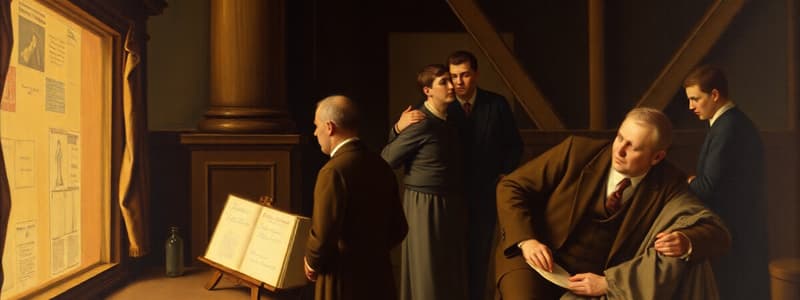Podcast
Questions and Answers
What was the main goal of the Short-Time Committees formed after the publication of Hobhouse's bill?
What was the main goal of the Short-Time Committees formed after the publication of Hobhouse's bill?
- To promote the passage of Hobhouse's bill in Parliament. (correct)
- To encourage child workers to strike against factory owners.
- To collect signatures for Richard Oastler's Ten-Hour Movement.
- To expand the bill's coverage to include all industries.
How did Richard Oastler initially attempt to address the issue of long working hours and child labor in factories?
How did Richard Oastler initially attempt to address the issue of long working hours and child labor in factories?
- By directly lobbying Members of Parliament to introduce labor reforms.
- By leading strikes and encouraging child workers to sabotage equipment.
- By publishing a letter in the Leeds Mercury criticizing child labor. (correct)
- By forming the Short-Time Committees to pressure factory owners.
What limitations existed in the initial labor bill promoted by John Hobhouse, leading to further activism?
What limitations existed in the initial labor bill promoted by John Hobhouse, leading to further activism?
- The bill only applied to adult workers, not child laborers.
- The bill was immediately repealed due to strong opposition from factory owners.
- The bill did not cover all industries and long workdays persisted. (correct)
- The bill was never officially passed by the Parliament.
Beyond parliamentary action, what additional strategies did Richard Oastler employ to advocate for labor reform?
Beyond parliamentary action, what additional strategies did Richard Oastler employ to advocate for labor reform?
What role did John Hobhouse play in the early efforts to reform working conditions?
What role did John Hobhouse play in the early efforts to reform working conditions?
Flashcards
Who was Richard Oastler?
Who was Richard Oastler?
Clothing merchant who wrote to the Leeds Mercury criticizing child labor in factories in 1830.
What were Short-Time Committees?
What were Short-Time Committees?
An organization formed by workers that focused on promoting bills in Parliament through meetings, demonstrations, and collecting signatures.
What was the Ten-Hour Movement?
What was the Ten-Hour Movement?
Movement led by Richard Oastler advocating for a maximum 10-hour workday.
Who was John Hobhouse?
Who was John Hobhouse?
Signup and view all the flashcards
What actions did Oastler encourage?
What actions did Oastler encourage?
Signup and view all the flashcards
Study Notes
- Richard Oastler, a clothing merchant, aimed to reform working hours.
- In 1830 he wrote a letter to Leeds Mercury to criticize employing young children in factories.
- John Hobhouse, a Member of Parliament, read the letter and sought to introduce a bill limiting child labor.
- Workers formed Short-Time Committees, promoting the bill’s passage through meetings, demonstrations, and collecting signatures.
- Despite the bill's passage, it did not cover all industries, so long workdays continued for many workers.
- Richard Oastler then led the Ten-Hour Movement.
- Oastler encouraged workers to strike, and child workers to sabotage factory equipment.
Studying That Suits You
Use AI to generate personalized quizzes and flashcards to suit your learning preferences.




